The longest time series for atmospheric CO2 is for the Pacific island of Mauna Loa. Based on this time series, the development of the CO2 level can be forecasted on a monthly basis.
January 2021
The CO2 growth season is now well under way, see Fig 1.
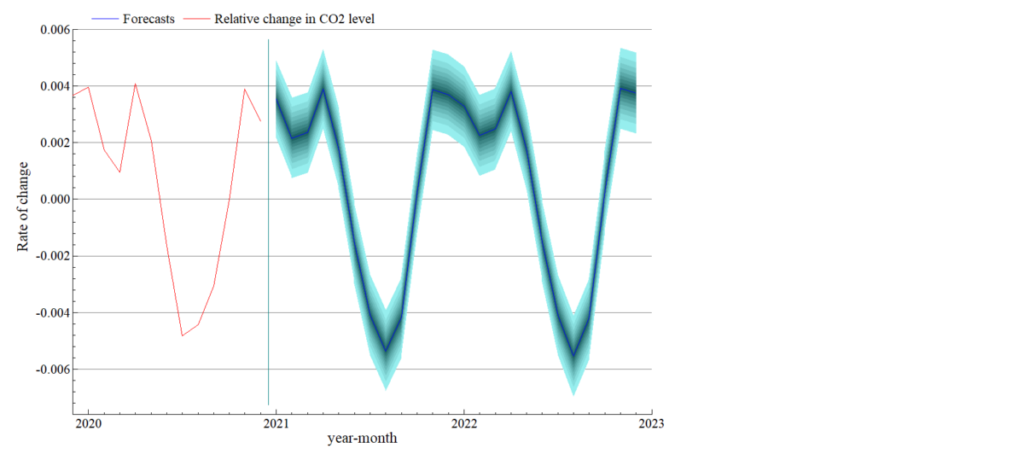
Although the seasonal variation dominates, the trend in the form of increased CO2 level, is clearly seen in the 24 period forecasts, shown for December 2020 and January 2021 in Fig. 2, with new all-time peaks forecasted for both 2021 and 2022.
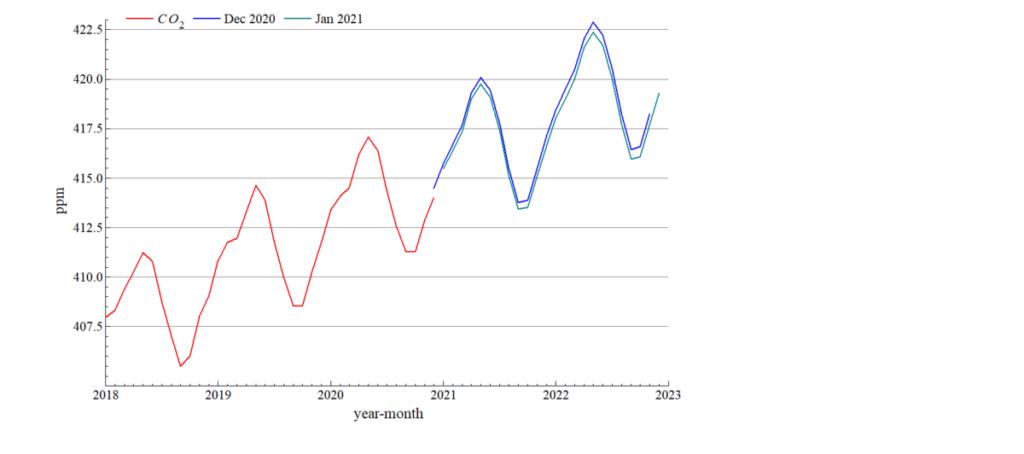
Link to xlsx file with forecasted numbers.
Posted 21 January 2021
November 2019 versusNovember 2020 forecasts
The figure shows graphs of the forecasts from November 2019 (conditional on October 2019 data) together with actuals and the current forecast, from November 2020. We see that the there is little surprise in the development: The actuals were rather accurately forecasted by the projections from a year ago, and there is good agreement between the two forecasts, where they overlap.

Link to xlxs file with forecasted numbers
Posted 16 Nov 2020.
As low as it gets…
The annual cycle of CO2 in the atmosphere over Mauna Loa is nearing its trough for 2020. The updated forecast shows that there is a 50-50 for the level to have increased already in October. The new peak is forecasted to occur in May 2021. The forecast uncertainty band for May 2021 shows that a peak only moderately higher than this year will be a big surprise.
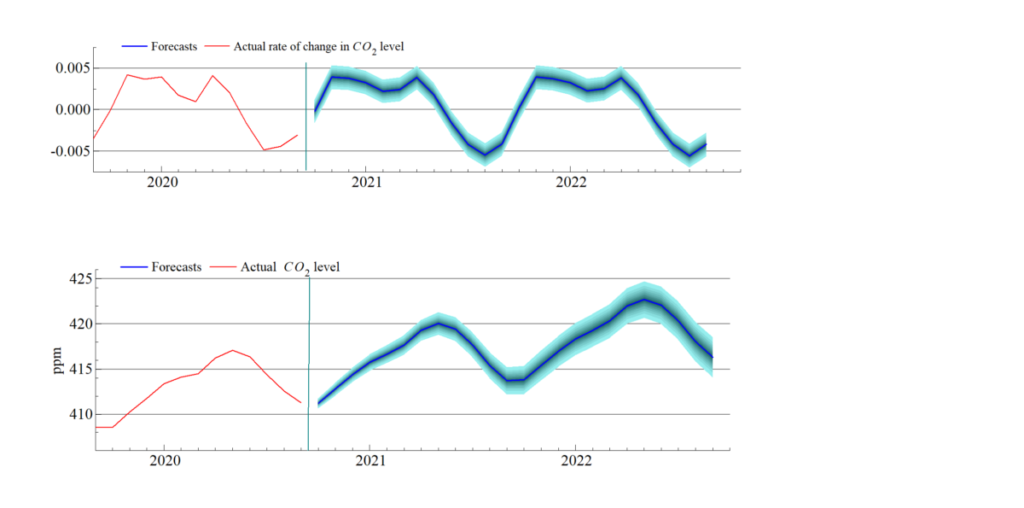
Link to xlxs file with the forecasted numbers.
Posted 22 October 2021
Full circle: One year of CO2 forecasts
The September 2020 forecasts of atmospheric CO2 at Mauna Loa marks one full year of monthly forecasts posted on Normetrics.no. The figure shows the actual CO2 level (green line graph) together with the new September 2020 forecast (blue) and the forecast form September 2019 (red).
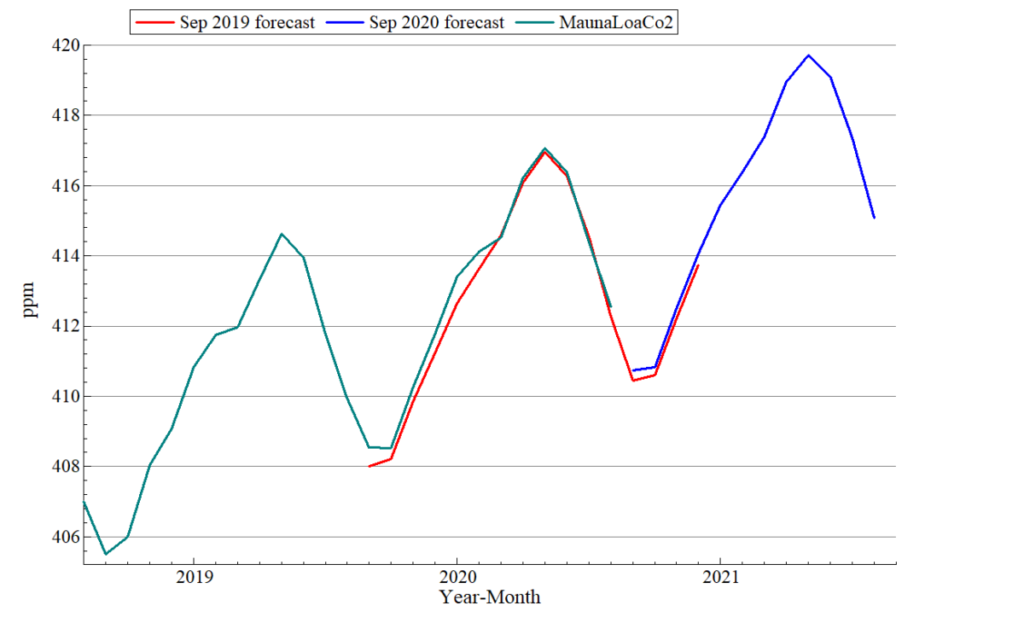
The September 2020 forecast underestimated the steepness of the Co2 during the autumn of 2019 somewhat. The peak in the April-June2020 was accurately forecasted though.
The difference between the two September forecasts is that 2020 is conditional on the CO2 level in August 2020, while the first forecast was conditional on August 2019. Although it is not large, the still visible difference between the two line graphs for September-December 2020, indicate that the difference in initial conditions had an impact on the forecasts.
Link to xlsx file with the forecasted numbers
Posted 15 September 2020
CO2 forecast update: A small reduction in the growth rate
The monthly average of atmospheric CO2 for July was 414.4 ppm which was a lower than the forecast conditional on June information, but not significantly lower.
The figure shows updated forecasts, conditional on data that includes July 2020. Panel a) in the figure shows the monthly rate of change. Interestingly, the point forecast for August (the middle of the fan) can be gauged to be a little lower than the rate of change one year earlier. However, since the level of CO2 has risen over the last year, the forecasted level (in log scale in panel b)) is higher for August 2020 than it was in August 2019.
The level of CO2 in the measured units of ppm is forecasts to continue its secular increase. The previous peak (417.07 ppm) form May 2020 is forecasted to be overtaken during the spring of 2021 with a new peak in May 2021 (418 ppm) and the next one in May 2022 (422 ppm).

Link to xslx file with the forecasted numbers.
Posted 11 August 2020.
CO2 forecast update: Seasonal reduction
After the historical peak in May 2020, the atmospheric CO2 level became reduced in June. However, this represents a predictable seasonal reduction, as the figure illustrates.
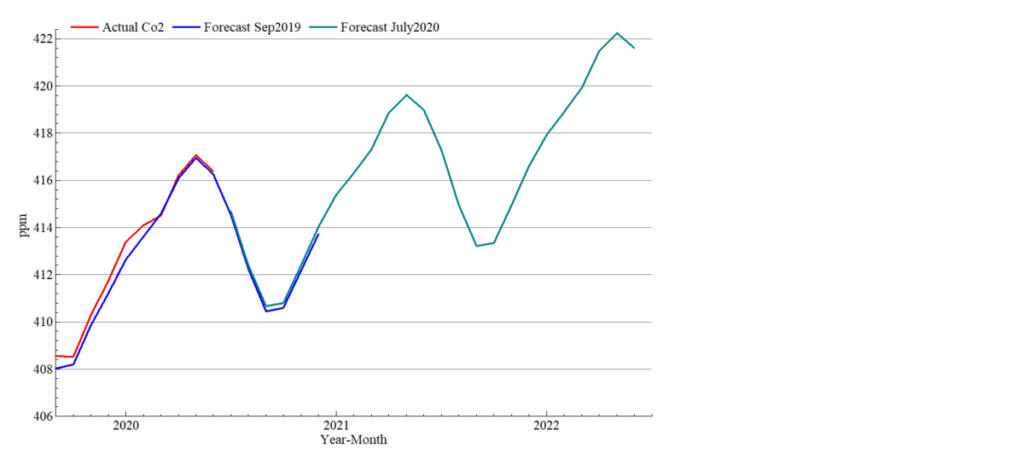
Link to xlsx file with the forecasted numbers (July 2020 forecasts)
Posted 18 July 2020
CO2 forecast update: May June 2020: A predictable new world record: May 2020 CO2 level a Mauna Loa
A noted in last month’s update of the Mauna Loa CO2 forecast, the record level for April 2020 became overtaken by May. Moreover, as noted, this peak was predictable on the basis of August 2019 information (the graph labelled September 2019 in the figure).

The latest forecast, June 2020 in the figure, predicts that the summer months will be dominated by the usual seasonal pattern, bringing the CO2 level to a low for 2020 in September and October, which will be significantly higher than the 2019 low, though.
Link to xlsx file with the forecasted numbers (June 2020 forecasts)
Posted 8 June 2022.
CO2 forecast update: May 2020
Data published by ESRL Global Monitoring Division shows that April 2002 became the month with the new CO2 record . This record has been correctly forecasted in this post since August 2019, as Figure 1 shows.
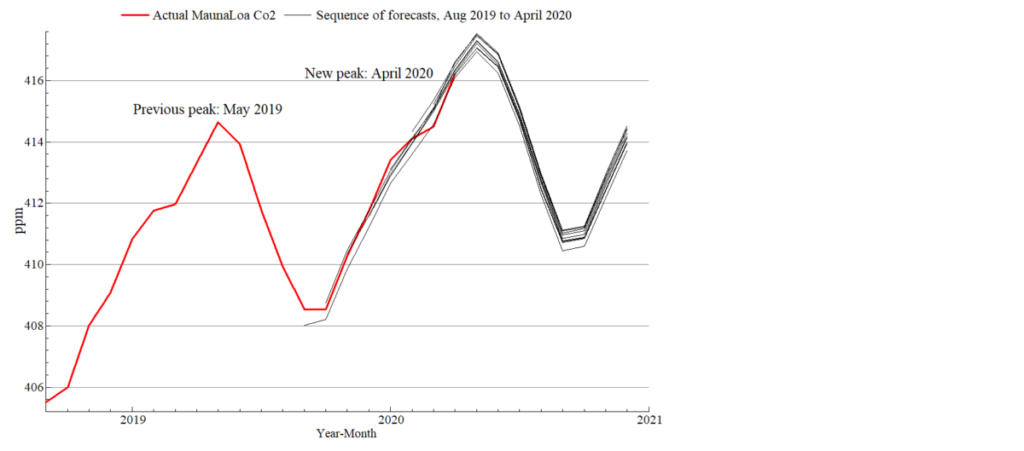
September 2019 as the first forecasted month and was conditional on August 2019 information. The newest has
May 2020 as the first forecast period (and is conditional on April 2020 information).
April’s world record may however soon be taken over by May 2020, since May is usually the month of the year with highest CO2 level in the athmosphere over Mauna Loa.
The new forecast (conditional on April 2020) indicates that the secular rise in the CO2 level in the athmosphere is continuing, and that May 2020 is likely to become the month with highest recorded level of CO2 in history, cf. the figure below.
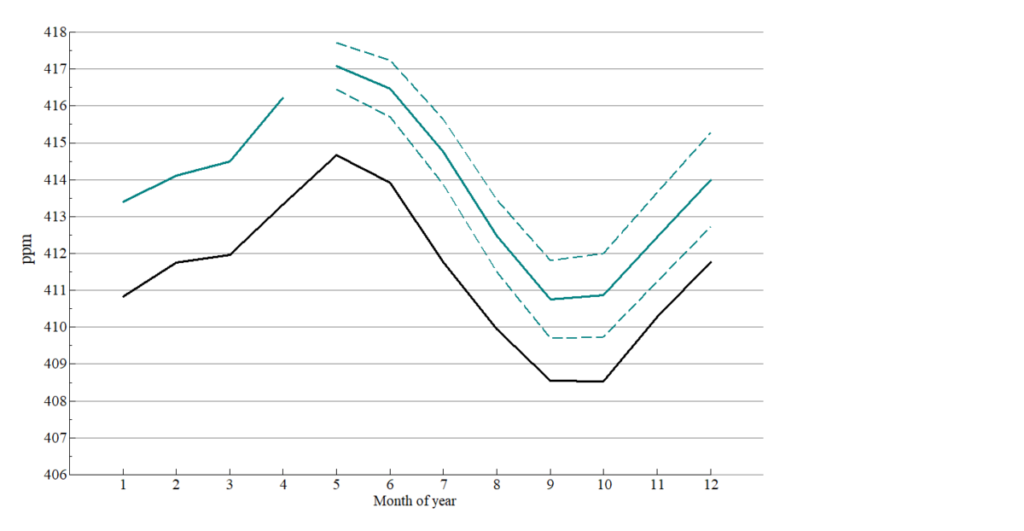
An interesting issue is whether the Covid-19 caused economic crisis has started to have an impact on the measured CO2 level. One indication of that would be if the number for May turns out to be below the dashed line representing the lower bound of the forecast confidence region.
Link to xlx file with the forecasted numbers.
Posted: 8 May 2020
CO2 forecast update: April 2020
Data published by ESRL Global Monitoring Division shows that the CO2 level measured in the athmosphere above Mauna Loa was 414.50 ppm in March. This is lower than the 415.2 ppm forecasted in the previous posting (6 March 2020). The over-prediction is marginally significant, as the lower bound of the 95 % forecast interval for March was 414.55 ppm.
The updated forecast for the rest of 2020 has been adjusted marginally down compared to the forecast from a month ago. This is a consequence of the measurement from March having become available.
The new forecast nevertheless indicates that the secular rise in the CO2 level in the athmosphere is continuing, and that April 2020 is likely to become the month with highest recorded level of CO2 in history, cf. the figure below.
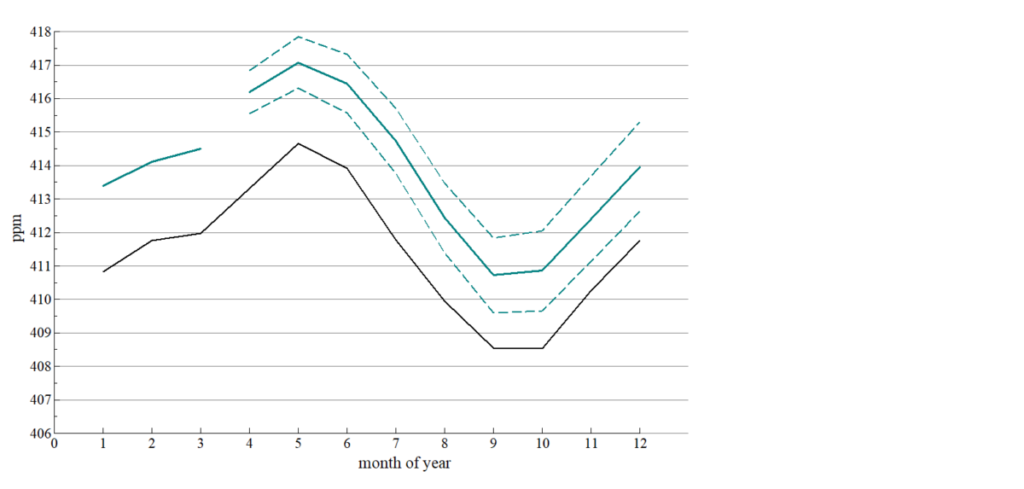
Link to xlsx with the forecasted numbers.
Posted 7 April 2020
CO2 forecast update: March 2020
The updated forecast supports our earlier forecasts saying that the CO2 level may reach a new all-time high already in March 2020, and that the level is likely to increase to more than 417 ppm in May 2020, significantly higher than the highest level recorded so far, which was for May 2019 (cf. the figure below.)
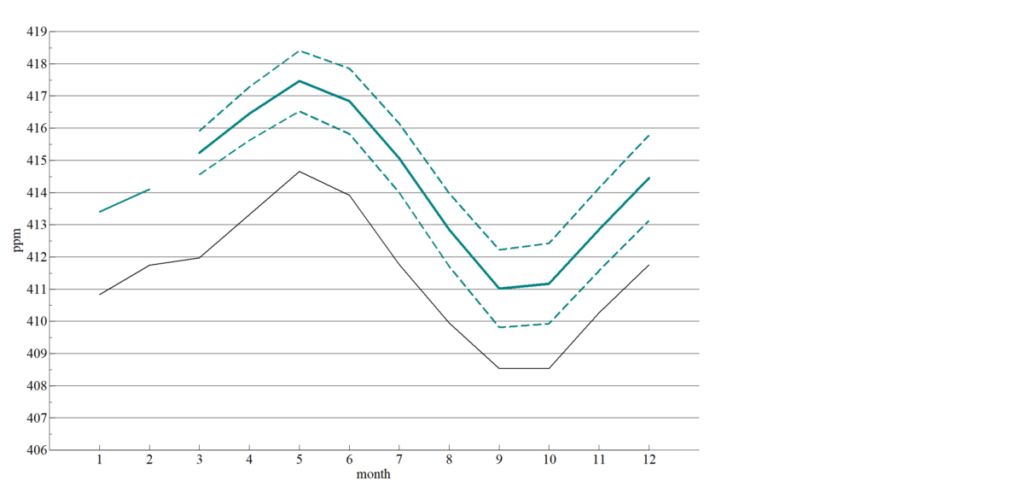
Link to xslx-file with the forecasted numbers.
Posted 6 March 2020
CO2 forecast update: February 2020
The atmospheric level of CO2 measured in January 2020 was 413.4 ppm (average for the month). The latest forecast for January was 413.12 ppm. The updated forecast predicts that the CO2 level may reach a new all-time high in March 2020, and that the level might increase to 417.548 ppm in May 2020, which is significantly higher than the highest level recorded so far, which was for May 2019.
These predictions are illustrated in the figure below, which shows the forecasts for 2020(2)-2020(12) in the same figure as the actuals for 2019(1)-2020(1) (the dotted line). The vertical distance between the dashed lines indicate 95 percent forecast intervals.
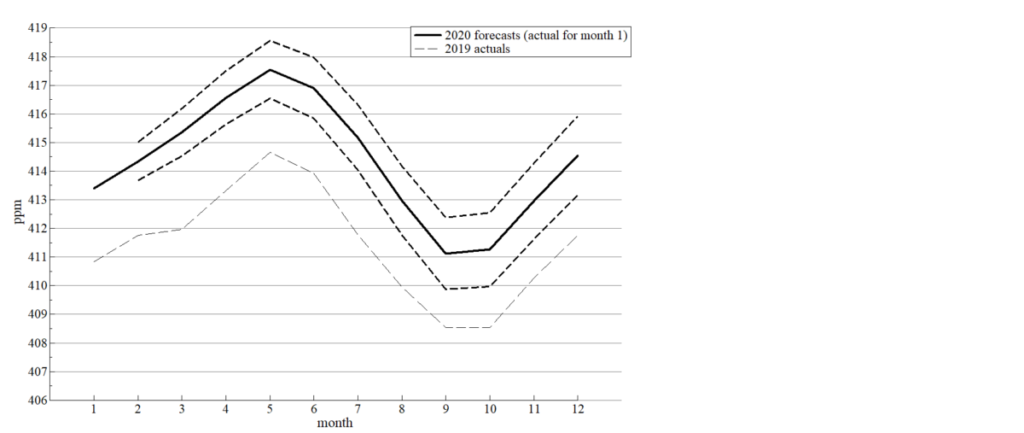
The numbers in 07feb2020_forecast.xlsx
Posted 7 February 2020
Previous forecast: January 2020
Figure 1 shows that the CO2 level is expected to continue its typical cyclical evolution in combination with secular growth.
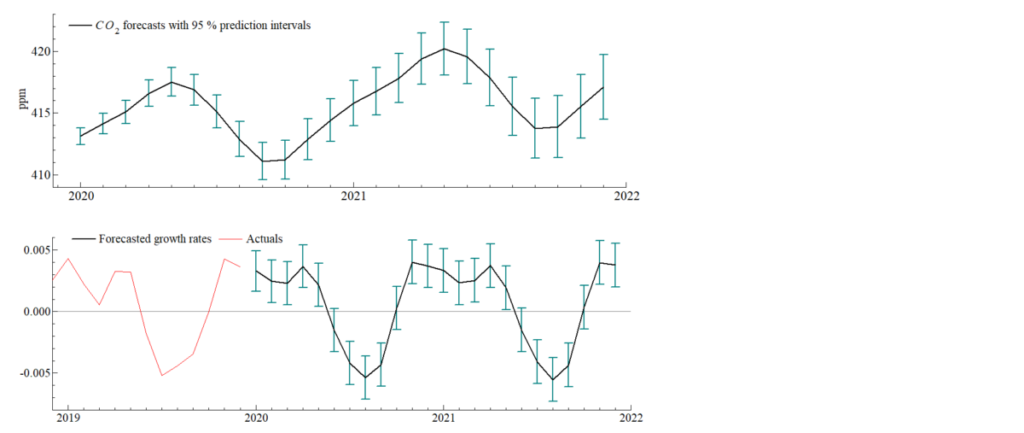
The next figure shows the actual CO2 measurement from 2019 together with the family of forecasts produced so far. Staring with the projection from September 2019 and ending with the current January 2020 forecast.
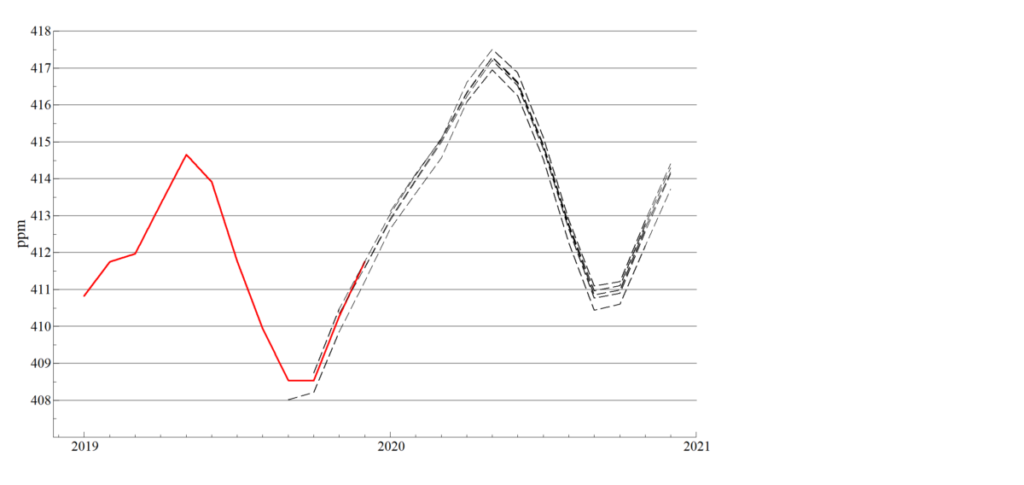
There is not a lot of differences between the five projections. The graphs show that the forecast from September 2019 has under-predicted CO2 evolution in the four last months of 2019 somewhat. The three other forecast from 2019 appear to be very precise (but there are also fewer observations to compare with).
Four of the five projections agree that a new “all time high” in atmospheric CO2 can become a reality already in March or April 2020.
Pdf file with the January 2020 forecasts: Januaryforecast.pdf
The data set with the January 2020 forecasts: jan2020_forecast.xlsx
Posted 9 January 2020
Previous forecast: December 2019
The figure shows forecasts for the 16 month period from December 2019 to March 2021
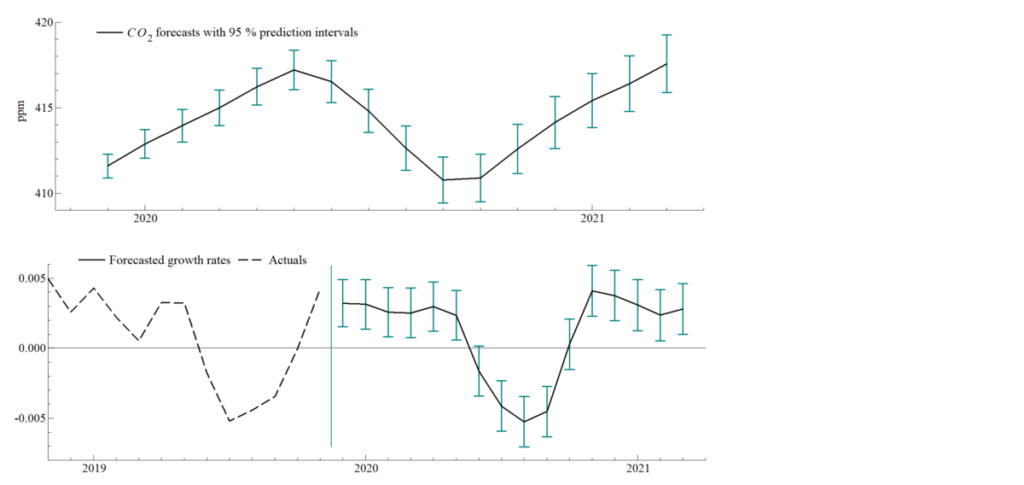
Forecasts produced 10 December 2019, based on data where CO2 in November 2019 is
the last observation. pdf version of the graph.
CO2 is forecasted to increase by 0.62 percent from December 2018 to December 2019. For the two 12 month periods ending in January and February 2020, the forecasted changes are 0.50 and 0.53 percent increases.
The graph below shows the forecasted CO2 level for the 12 months from December 2019 to November 2020 compared with the actual CO2 levels in the 12 months for December 2018 to November 2019.
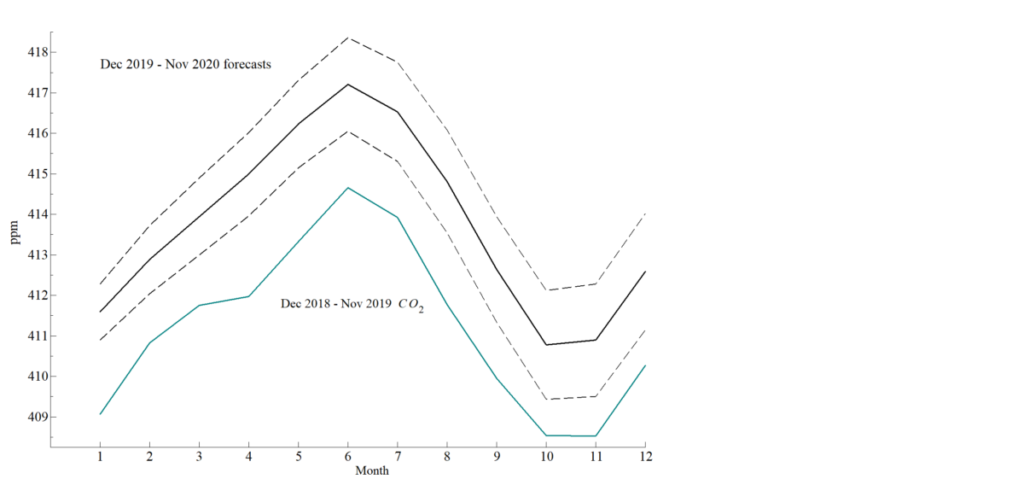
The graphs in the figure indicate that the forecasted CO2 level over the next 12 months are significantly higher than the latest historical levels for the same months.
The forecasted numbers are available in 10dec20019_forecast.xlsx
Posted 10 december 2019 (Normetrics.no)
Previous forecast: November 2019
The figure shows forecasts for the 16 month period from November 2019 to February 2021
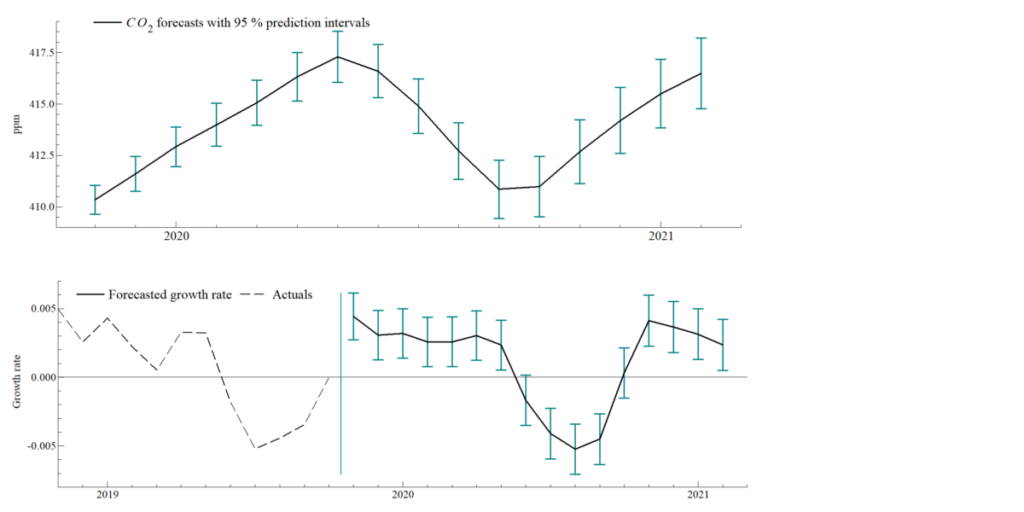
According to this forecast, CO2 is excpected to increase by 0.57 percent from November 2018 to November 2019. For the two 12 month periods ending in December 2019 and January 2020, the forecasted changes are 0.62 and 0.43 percent increases.
The graph below shows the forecasted CO2 level for the 12 months from November 2019 to October 2020 compared with the actual CO2 levels in the 12 months from November 2018 to October 2019.
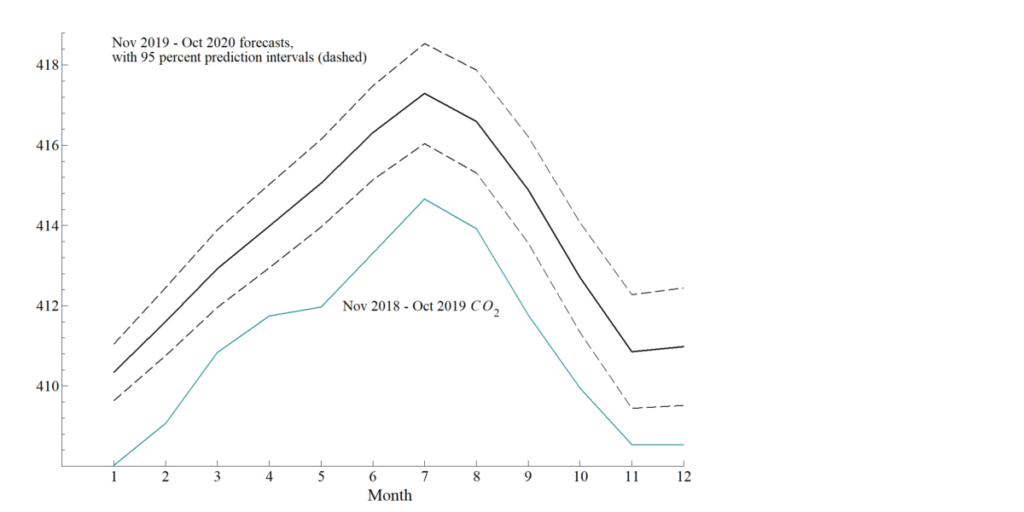
The graphs indicate that forecasted CO2 level over the next 12 months are significantly higher than the latest historical levels for the same months.
The forecasted numbers are in 19nov2019.xlsx .
Previous forecast: October 2019
The graph below shows forecasts for the 16 month period from October 2019 to January 2021.
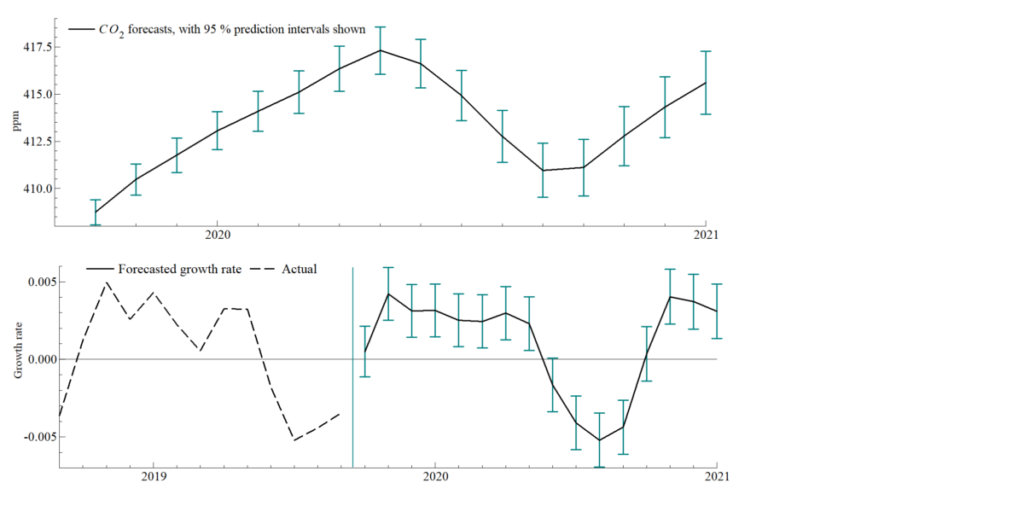
According to this forecast CO2 is expected to increase by 0.58 percent from October 2019 to October 2020. For the two 12 month periods ending in November and December 2019, the forecasts are 0.56 and 0.62 percent increases.
The forecasted numbers are in 23oct20019_forecast.xlsx .
Previous forecast: September 2019
The graph below shows the previous forecast, for the period from September 2019 to December 2020.

The forecasted numbers are in 23sept2019_forecast.xlsx
The forecasted value for September 2019 was 408.05 ppm, while the actual monthly average was 408.54 pmm. The forecast was just inside the upper bound of the 95 % forecast bound (408,69 ppm).
Institutional forecasts
Forecasts of Mauna Loa CO2 have been published by among others, the UK Met.office: https://www.metoffice.gov.uk/research/climate/seasonal-to-decadal/long-range/forecasts/co2-forecast. These forecasts, produced by large instituions, are high-quality and are based on extensive measurements and the use of scientific models.
Methodology
The forecasts on this page only use the information in the time series itself, and that information is processed with the use of methods originally developed for empirical macroeconometric modelling, see Doornik og Hendry (2018, Ch. 14.8), Henry og Doornik (2014), Nymoen (2019, Ch. 11), among others. This means that the forecasts can be updated soon after the publication of a new monthly mean of atmospheric CO2 over Mauna Loa has been published. In each forecast round the forecasting function is updated withe the use an alogrithm of for automatic model specification
References:
Data: https://www.esrl.noaa.gov/gmd/ccgg/trends/data.html, Dr. Pieter Tans, NOAA/ESRL (www.esrl.noaa.gov/gmd/ccgg/trends/) and Dr. Ralph Keeling, Scripps Institution of Oceanography (scrippsco2.ucsd.edu/)
Method:
David F. Hendry and Jurgen A. Doornik (2014): Empirical Model Discovery and Theory Evaluation. Automatic Selection Methods in Econometrics, MIT, Press.
David F. Hendry and Jurgen A. Doornik (2018): Empirical Econometric Modelling. PcGive 15. Volume I. Timberlake Consultants.
Ragnar Nymoen (2019) Dynamic Econometrics for Macroeconomic Modelling, World Scientific.
